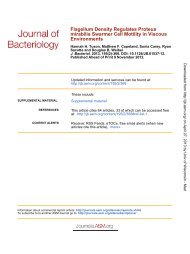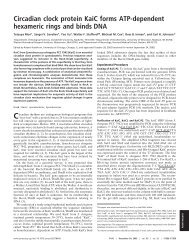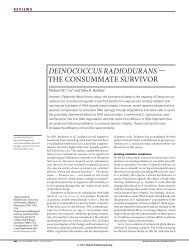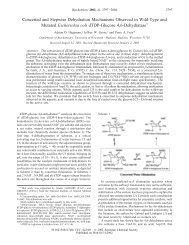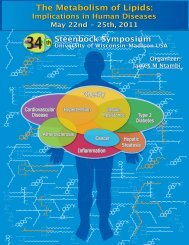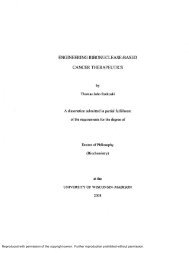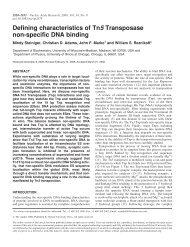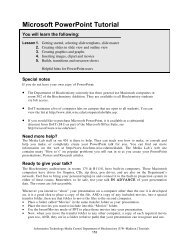A Potent, Versatile Disulfide-Reducing Agent from Aspartic Acid
A Potent, Versatile Disulfide-Reducing Agent from Aspartic Acid
A Potent, Versatile Disulfide-Reducing Agent from Aspartic Acid
You also want an ePaper? Increase the reach of your titles
YUMPU automatically turns print PDFs into web optimized ePapers that Google loves.
A <strong>Potent</strong>, <strong>Versatile</strong> <strong>Disulfide</strong>-<strong>Reducing</strong> <strong>Agent</strong> <strong>from</strong> <strong>Aspartic</strong> <strong>Acid</strong><br />
John C. Lukesh, III, † Michael J. Palte, ‡,§ and Ronald T. Raines* ,†,∥<br />
† Department of Chemistry, ‡ Medical Scientist Training Program, § Molecular & Cellular Pharmacology Graduate Training Program,<br />
and ∥ Department of Biochemistry, University of Wisconsin−Madison, Madison, Wisconsin 53706, United States<br />
*S Supporting Information<br />
ABSTRACT: Dithiothreitol (DTT) is the standard<br />
reagent for reducing disulfide bonds between and within<br />
biological molecules. At neutral pH, however, >99% of<br />
DTT thiol groups are protonated and thus unreactive.<br />
Herein, we report on (2S)-2-amino-1,4-dimercaptobutane<br />
(dithiobutylamine or DTBA), a dithiol that can be<br />
synthesized <strong>from</strong> L-aspartic acid in a few high-yielding<br />
steps that are amenable to a large-scale process. DTBA has<br />
thiol pK a values that are ∼1 unit lower than those of DTT<br />
and forms a disulfide with a similar E°′ value. DTBA<br />
reduces disulfide bonds in both small molecules and<br />
proteins faster than does DTT. The amino group of<br />
DTBA enables its isolation by cation-exchange and<br />
facilitates its conjugation. These attributes indicate that<br />
DTBA is a superior reagent for reducing disulfide bonds in<br />
aqueous solution.<br />
Approximately 20% of human proteins are predicted to<br />
contain disulfide bonds between cysteine residues. 1 Smallmolecule<br />
thiols can reduce these (and other) disulfide bonds,<br />
thereby modulating biomolecular function. 2 The reaction<br />
mechanism involves thiol−disulfide interchange initiated by a<br />
thiolate. 3 The ensuing mixed disulfide can become trapped if<br />
the reagent is a monothiol, such as β-mercaptoethanol (βME). 4<br />
To overcome this problem, Cleland developed racemic (2S,3S)-<br />
1,4-dimercaptobutane-2,3-diol (dithiothreitol or DTT; Table<br />
1), a dithiol that resolves a mixed disulfide by forming a sixmembered<br />
ring. 2a,5 DTT is a potent reducing agent (E°′ =<br />
−0.327 V), 2g and has been the preferred reagent for the<br />
quantitative reduction of disulfide bonds for decades, despite its<br />
high cost. 6,7<br />
At physiological pH, DTT is a sluggish reducing agent. The<br />
reactivity of a dithiol is governed by the lower of its two thiol<br />
pKa values. 2,3 With its lower thiol pKa value being 9.2 (Table 1),<br />
Journal of the American Chemical Society Communication<br />
Scheme 1<br />
Figure 1. Time-course for the reduction of a mixed disulfide in small<br />
molecules by DTBA and DTT in 50 mM potassium phosphate buffer.<br />
DTBA DTT DTBA (A) Reduction of oxidized βME; kobs /kobs = 3.5 at pH 7.0; kobs /<br />
DTT DTBA kobs = 4.4 at pH 5.5. (B) Reduction of oxidized L-glutathione; kobs /<br />
DTT kobs = 5.2 at pH 7.0.<br />
and 4.4-fold faster at pH 5.5 (Figure 1A). These rate<br />
accelerations are commensurate with the lower thiol pK a of<br />
DTBA. At pH 7.0, DTBA reduces oxidized L-glutathione 5.2fold<br />
more rapidly than does DTT (Figure 1B). As oxidized L-<br />
4058<br />
glutathione has a net charge of −2 near neutral pH, a favorable<br />
Coulombic interaction could contribute to this higher rate<br />
acceleration.<br />
DTBA is also an efficacious reducing agent for disulfide<br />
bonds in proteins. A cysteine residue resides within the active<br />
site of papain (Cys25) and near that of creatine kinase<br />
(Cys283). Forming a mixed disulfide with those cysteine<br />
residues is known to eliminate their enzymatic activities. 2c,18<br />
These two enzymes differ, however, in the electrostatic<br />
environment of their active sites. The active site of papain is<br />
hydrophobic like its substrates, though there is an anionic<br />
region nearby (Figure 2A). 19 In contrast, the active site of<br />
Figure 2. Time-course for the reduction of a mixed disulfide in<br />
enzymic active sites by DTBA and DTT in 0.10 M imidazole−HCl<br />
buffer, pH 7.0, containing EDTA (2 mM). (A) Reduction of papain-<br />
DTBA DTT Cys35−S−S−CH3; kobs /kobs = 14. (B) Reduction of creatine<br />
kinase-Cys283−S−S−L-glutathione; k obs<br />
DTBA /kobs<br />
DTT = 1.1. Insets: Electro-<br />
static potential maps with red = anionic and blue = cationic, as<br />
generated by the program PyMOL (Schrödinger, Portland, OR) using<br />
PDB entries 1ppn 19b and 2crk. 20<br />
creatine kinase is cationic, complementary to its anionic<br />
substrates (Figure 2B). 20,21a−c We found that DTBA reduces<br />
a disulfide bond in the hydrophobic/anionic active site of<br />
papain 14-fold faster than does DTT (Figure 2A). In contrast,<br />
the two reagents reduce a disulfide bond near the cationic<br />
active site of creatine kinase at a similar rate.<br />
The amino group of DTBA confers additional benefits. For<br />
example, a disulfide-reducing agent that can be readily isolated,<br />
regenerated, and reused incurs less cost and generates less<br />
waste. 22 Moreover, extraneous disulfide bonds absorb light at<br />
280 nm, which can confound standard measurements of<br />
protein concentration. 23 We reasoned that DTBA could be<br />
isolated by its adsorption to a cation-exchange resin. Indeed,<br />
>99% of DTBA (but
Journal of the American Chemical Society Communication<br />
resin (see: Supporting Information). We also note that the<br />
amino group of DTBA enables its covalent attachment to a<br />
soluble molecule, resin, or surface by simple reactions, such as<br />
reductive amination (which preserves the cationic charge) or<br />
N-acylation. We conclude that the attributes of DTBA could<br />
enable it to supplant DTT as the preferred reagent for reducing<br />
disulfide bonds in biomolecules.<br />
■ ASSOCIATED<br />
CONTENT<br />
*S Supporting Information<br />
Experimental protocols and analytical data. This material is<br />
available free of charge via the Internet at http://pubs.acs.org.<br />
■ AUTHOR<br />
INFORMATION<br />
Corresponding Author<br />
rtraines@wisc.edu<br />
Notes<br />
The authors declare no competing financial interest.<br />
■ ACKNOWLEDGMENTS<br />
We are grateful to Professor W. W. Cleland and S. B. Johnston<br />
for enabling advice, and to N. McElfresh for preliminary work<br />
on this project. M.J.P. was supported by Molecular and Cellular<br />
Pharmacology Training Grant T32 GM008688 (NIH) and<br />
predoctoral fellowship 09PRE2260125 (American Heart<br />
Association). This work was supported by Grant R01<br />
GM044783 (NIH).<br />
■ REFERENCES<br />
(1) Martelli, P. L.; Fariselli, P.; Cadadio, R. Proteomics 2004, 4,<br />
1655−1671.<br />
(2) (a) Cleland, W. W. Biochemistry 1964, 3, 480−482. (b) Jocelyn,<br />
P. C. Biochemistry of the SH Group: The Occurence, Chemical Properties,<br />
Metabolism and Biological Function of Thiols and Disulphides; Academic<br />
Press: London, U.K., 1972. (c) Smith, D. J.; Maggio, E. T.; Kenyon, G.<br />
L. Biochemistry 1975, 14, 766−771. (d) Ranganathan, S.; Jayaraman,<br />
N. Chem. Commun. 1991, 934−936. (e) Burns, J. A.; Butler, J. C.;<br />
Moran, J.; Whitesides, G. M. J. Org. Chem. 1991, 56, 2648−2650.<br />
(f) Lees, W. J.; Singh, R.; Whitesides, G. M. J. Org. Chem. 1991, 56,<br />
7328−7331. (g) Lamoureux, G. V.; Whitesides, G. M. J. Org. Chem.<br />
1993, 58, 633−641. (h) Singh, R.; Whitesides, G. M. Bioorg. Chem.<br />
1994, 22, 109−115. (i) Gilbert, H. F. Methods Enzymol. 1995, 251, 8−<br />
28. (j) Singh, R.; Lamoureux, G. V.; Lees, W. J.; Whitesides, G. M.<br />
Methods Enzymol. 1995, 251, 167−173. (k) Getz, E. B.; Xiao, M.;<br />
Chakrabarty, T.; Cooke, R.; Selvin, P. R. Anal. Biochem. 1999, 273,<br />
73−80. (l) Cline, D. J.; Redding, S. E.; Brohawn, S. G.; Psathas, J. N.;<br />
Schneider, J. P.; Thorpe, C. Biochemistry 2004, 43, 15195−15203.<br />
(3) (a) Whitesides, G. M.; Lilburn, J. E.; Szajewski, R. P. J. Org. Chem.<br />
1977, 42, 332−338. (b) Snyder, J. P.; Carlsen, L. J. Am. Chem. Soc.<br />
1977, 99, 2931−2942. (c) Rosenfield, R. E.; Parthasarathy, R.; Dunitz,<br />
J. D. J. Am. Chem. Soc. 1977, 99, 4860−4862. (d) Shaked, Z.;<br />
Szajewski, R. P.; Whitesides, G. M. Biochemistry 1980, 19, 4156−4166.<br />
(e) Houk, J.; Whitesides, G. M. J. Am. Chem. Soc. 1987, 109, 6825−<br />
6836. (f) Keire, D. A.; Strauss, E.; Guo, W.; Noszal, B.; Rabenstein, D.<br />
L. J. Org. Chem. 1992, 57, 123−127. (g) Rothwarf, D. M.; Scheraga, H.<br />
A. Proc. Natl. Acad. Sci. U.S.A. 1992, 89, 7944−7948. (h) Fernandes, P.<br />
A.; Ramos, M. J. Chem.Eur. J. 2004, 10, 257−266.<br />
(4) βME is also an unstable, foul-smelling liquid 2f,3a,d with a high<br />
reduction potential and high thiol pK a (Table 1).<br />
(5) Evans, R. M.; Fraser, J. B.; Owen, L. N. J. Chem. Soc. 1947, 248−<br />
255.<br />
(6) The current price of DTT is 10 2 -fold greater per thiol group than<br />
that of βME (Sigma−Aldrich, St. Louis, MO).<br />
4059<br />
(7) Tris(2-carboxyethyl)phosphine (TCEP) is more potent than<br />
DTT at reducing disulfide bonds between small molecules 2e but not<br />
within proteins. 2l<br />
(8) Another commercial dithiol, bis(2-mercaptoethyl) sulfone<br />
(BMS), has low thiol pK a values of 7.9 ± 0.2 and 9.0 ± 0.2. 2g Upon<br />
oxidation, however, BMS forms a seven-membered ring with E°′ =<br />
(−0.291 ± 0.002) V (Figure S3), making BMS a less potent reducing<br />
agent than DTT.<br />
(9) (a) Coppola, G. M.; Schuster, H. F. Asymmetric Synthesis:<br />
Construction of Chiral Molecules Using Amino <strong>Acid</strong>s; John Wiley & Sons:<br />
New York, NY, 1987. (b) McCaldon, P.; Argos, P. Proteins 1988, 4,<br />
99−122.<br />
(10) Carbamate derivatives of DTBA are known. (a) Kessler, P.;<br />
Servent, D.; Hirth, C. Tetrahedron Lett. 1994, 35, 7237−7240.<br />
(b) Servent, D.; Meńez, A.; Kessler, P. FEBS Lett. 1995, 360, 261−265.<br />
(11) Mitsunobu, O.; Masahiko, E. Bull. Chem. Soc. Jpn. 1971, 44,<br />
3427−3430.<br />
(12) Jencks, W. P.; Salvesen, K. J. Am. Chem. Soc. 1971, 93, 4433−<br />
4436.<br />
(13) Connett, P. H.; Wetterhahn, K. E. J. Am. Chem. Soc. 1986, 108,<br />
1842−1847.<br />
(14) Lees, W. J.; Whitesides, G. M. J. Org. Chem. 1993, 58, 642−647.<br />
(15) (a) Benesch, R. E.; Benesch, R. J. Am. Chem. Soc. 1955, 77,<br />
5877−5881. (b) Woycechowsky, K. J.; Wittrup, K. D.; Raines, R. T.<br />
Chem. Biol. 1999, 6, 871−879.<br />
(16) The amino group of DTBA is assumed to be cationic<br />
throughout its pH-titration, as cysteamine has an amino pK a of<br />
10.44. 13<br />
(17) Chivers, P. T.; Prehoda, K. E.; Raines, R. T. Biochemistry 1997,<br />
36, 4061−4066.<br />
(18) (a) Roberts, D. D.; Lewis, S. D.; Ballou, D. P.; Olson, S. T.;<br />
Shafer, J. A. Biochemistry 1986, 25, 5595−5601. (b) Singh, R.; Blattler,<br />
W. A.; Collinson, A. R. Anal. Biochem. 1993, 213, 49−56.<br />
(19) (a) Schechter, I.; Berger, A. Biochem. Biophys. Res. Commun.<br />
1967, 27, 157−162. (b) Pickersgill, R. W.; Harris, G. W.; Garman, E.<br />
Acta Crystallogr., Sect. B 1992, 48, 59−67.<br />
(20) Rao, J. K. M.; Bujacz, G.; Wlodawer, A. FEBS Lett. 1998, 439,<br />
133−137.<br />
(21) (a) Putney, S.; Herlihy, W.; Royal, N.; Pang, H.; Aposhian, H.<br />
V.; Pickering, L.; Belagaje, R.; Biemann, K.; Page, D.; Kuby, S.;<br />
Schimmel, P. J. Biol. Chem. 1984, 259, 4317−4320. (b) Chen, L. H.;<br />
Borders, C. L.; Vasquez, J. R.; Kenyon, G. L. Biochemistry 1996, 35,<br />
7895−7902. (c) Hurne, A. M.; Chai, C. L. L.; Waring, P. J. Biol. Chem.<br />
2000, 275, 25202−25206.<br />
(22) (a) Amos, R. A.; Fawcett, S. M. J. Org. Chem. 1984, 49, 2637−<br />
2639. (b) Woycechowsky, K. J.; Hook, B. A.; Raines, R. T. Biotechnol.<br />
Prog. 2003, 19, 1307−1314. (c) Bienvenu, C.; Greiner, J.; Vierling, P.;<br />
Di Giorgio, C. Tetrahedron Lett. 2010, 51, 3309−3311.<br />
(23) Walker, J. M., Ed. The Protein Protocols Handbook, 3rd ed.;<br />
Humana Press: Totowa, NJ, 2009.<br />
dx.doi.org/10.1021/ja211931f | J. Am. Chem. Soc. 2012, 134, 4057−4059



